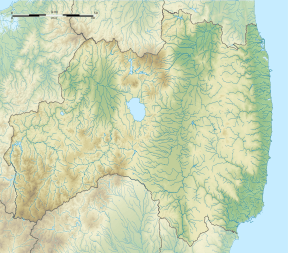Miyahata Site
Miyahata Site (宮畑遺跡, Miyahata iseki) is a Jōmon period archaeological site and archaeological park located in what is now part of the city of Fukushima, Fukushima Prefecture in the Tōhoku region of Japan. The site was designated a National Historic Site of Japan in 2003.[1]
宮畑遺跡 | |
 Miyahata | |
 Miyahata  Miyahata Site (Japan) | |
| Location | Fukushima, Fukushima, Japan |
|---|---|
| Region | Tohoku region |
| Coordinates | 37°47′24″N 140°30′55″E |
| Type | settlement |
| History | |
| Periods | Jōmon period |
| Site notes | |
| Ownership | National Historic Site |
| Public access | Yes |
Overview
The Miyahata site contains the overlapping ruins of a Jōmon period village from the middle Jōmon period (4500–4000 years ago), late Jōmon period (4000–3000 years ago) and final Jōmon period (3000–2500 years ago)
The middle Jōmon period ruins consist of over 40 pit dwellings, of which over half appear to have been destroyed at the same time in a fire. The late Jōmon period ruins consist of pit dwellings with stone cobblestone floors in a style more often found the in Kantō region of Japan. Pottery fragments also consistent with the Kantō region, including some pottery burial jars were also uncovered. As these ruins are not contiguous with in time with the middle Jōmon period ruins, it appears that the village was abandoned after its conflagration, and resettled by migrants from another region of Japan. The final Jōmon period ruins consist of raised floor buildings arranged unevenly around a circular plaza, including a rectangular building with gigantic columns with a diameter of 90-cm, which is presumed to have been used for some ritual purpose.
The site is open to the public as an archaeological park with several reconstructed buildings and a museum.
References
- "宮畑遺跡" [Miyahata iseki] (in Japanese). Agency for Cultural Affairs.
External links
- Fukushima city home page (in Japanese)
- Fukushima Regional Portal (in Japanese)